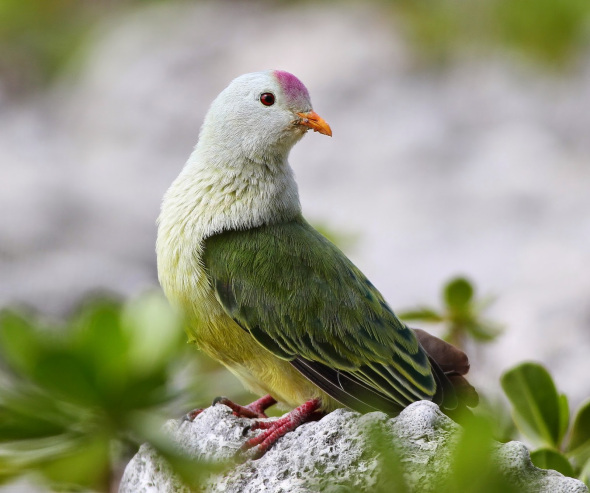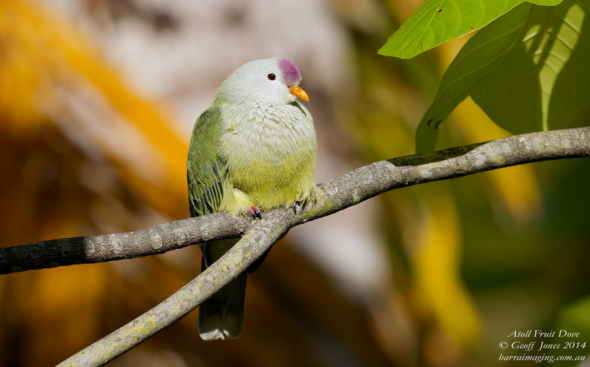ENDANGERED SPECIES FRIDAY: PTILINOPUS CORALENSIS | ATOLL FRUIT DOVE.

ENDANGERED SPECIES FRIDAY: PTILINOPUS CORALENSIS | ATOLL FRUIT DOVE
This Friday’s Endangered Species Post brushes up on a species of bird that many of you may never have heard of. The atoll fruit dove, that’s listed as (near threatened) is unfortunately nearing extinction within its endemic wild. Image: Atoll Fruit Dove, credits, Steve Smith.
Endemic to French Polynesia, the species was formally identified back in 1848 by Dr Titian Ramsay Peale (November 2, 1799 – March 13, 1885) who was an American artist, naturalist, entomologist, and photographer. He was the sixteenth child and youngest son of noted American naturalist Charles Willson Peale. He is sometimes referred to as Titian Ramsey Peale II to distinguish him from his older brother with the same name who was a favorite of their father and who died at age 18 in 1798.
From 1988 the atoll fruit dove was previously listed as lower risk/least concern, data from that period showed no reasonable justification for the bird to be listed as threatened due to the species being heavily populated throughout the French Polynesia islands. Unfortunately things have drastically changed since the the late 1980’s. French Polynesia is now home to many French and non-French citizens, all of which are gradually threatening the atoll fruit doves habitat - and many other animals too.
Data records prove that from the 1980’s right through to the new millennium the species did live a pretty undisturbed life. However come 2004 the atoll fruit doves habitat and their existence took a turn for the worse. From 2004-2016 the species was (re-listed as near threatened). Populations are still decreasing, and from what we are aware of to date, there has been no official records kept that can prove the current population size which we do find rather strange. French Polynesia isn’t exactly your largest island on the planet.
What does near threatened mean though? Below I’ve extracted a paragraph from the International Union for the Conservation of Nature that will help you understand more about this ‘category‘.
“A taxon is Near Threatened when it has been evaluated against the criteria but does not qualify for Critically Endangered, Endangered or Vulnerable now, but is close to qualifying for or is likely to qualify for a threatened category in the near future“
Scientifically identified as Ptilinopus coralensis, the species is widespread throughout the islands of the Tuamotu Archipelago, French Polynesia. It is likely to occur at low densities throughout its range as its preferred food resources are scarce. In a recent survey it was found to be uncommon on five out of eight islands visited, but others have found it to be abundant on some atolls which have remained free from the ravages of introduced predators.
Scientists haven’t as located any ‘sub-populations’, however have confirmed that there is a ‘continuous decline of mature individuals on the island examined’ however as yet we still don’t know to what extent other than a 30% drop in populations have been recorded.

Image: (Google Image Search): Atoll fruit dove (Credits: Geoff Jones 2014)
The atoll fruit dove is the world’s only dove in the tropical Pacific that has adapted exclusively to low coral atolls. It lives in forests and abandoned coconut plantations. It mainly feeds on insects and seeds, usually on the ground. This species also eats the leaves of the “tafano” or “kahaia” (Guettarda speciosa ) trees with odorous flowers.
THREATS
Predation by introduced rats (particularly black rat Rattus rattus) is a threat on a small number of atolls and the species is vulnerable to habitat destruction including the exploitation of coconut plantations. The species is also reported to be rather tame, and is rare on inhabited islands, so hunting may also be a threat.
Although the species is commonly known throughout the French Polynesian islands - there is still to date very little known about the bird. The issue with coconut plantation/exploitation has always been somewhat of a concern for myself and the team. In a sense its no different to be honest than the palm oil trade (however in this case, its coconut farming that is placing the species in danger to some extent!).
I am working with a number of conservationists on the French Polynesia islands that are keeping me updated on this issue overseas, as well as the cruel and barbaric dog and cat meat trade. For now our main priority is to ensure that we undertake a census in relation to the current atoll fruit dove population, examine the threats, and work how to minimize them threats (Etc).. ..Unfortunately though I cannot provide any further up to date information relating to this bird and whether the specie will be extinct soon.
Dr Jose Carlos Depre: PhD. MEnvSc. BSc(Hons) Botany, PhD(NeuroSci) D.V.M
Master of Environmental, Botanical & Human Science.
Chief Environmental Officer and CEO.



Thank you for your reply, should it merit a response we will respond in due course. This site is owned by International Animal Rescue Foundation and moderation is used.